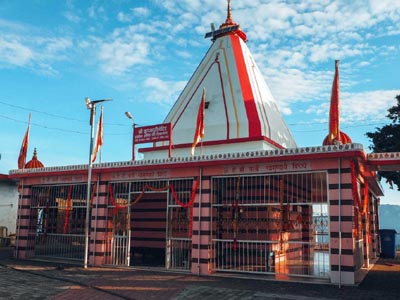Dehradun, cradled in the serene embrace of the Doon Valley, lies at the foothills of the majestic Himalayas. This enchanting city is flanked by the Song River—a graceful tributary of the sacred Ganges—on the east, and the tranquil Asan River, flowing from the mighty Yamuna, on the west. Known for its breathtaking landscapes, pleasant climate, and lush greenery, Dehradun is not just a city, but a scenic symphony—offering a perfect gateway to the mystical hills of Uttarakhand, including Mussoorie, Rishikesh, and beyond. With its blend of natural beauty and cultural charm, Dehradun is where the mountains whisper stories and rivers sing songs of timeless tranquility.
Robber's Cave
Robber's Cave, locally known as Guchhupani, is one of Dehradun’s most intriguing natural wonders. Tucked away just a few kilometers from the city center, this mystical cave formation is a paradise for nature lovers and thrill-seekers alike. The cave stretches for about 600 meters, split into two main parts, with a cold stream of water flowing right through it — often ankle- to knee-deep — inviting visitors to walk barefoot on its smooth, stone floor.
Whether you're wading through the stream, marveling at the natural rock formations, or simply soaking in the cool, cave-like calm, Robber’s Cave feels like a hidden world carved by nature itself — a perfect escape from the bustle of the city into something truly timeless.

Sahastradhara
Sahastradhara, meaning "Thousand-fold spring", is a captivating natural marvel located in the Dehradun district of Uttarakhand. Renowned for its sulphur-rich water, therapeutic pools, and stunning limestone formations, this destination draws visitors year-round seeking natural beauty, peace, and rejuvenation.
One of the most iconic features of this site is the Sahastradhara Ropeway, a modern aerial cable car that rises gracefully above the cascading waterfall and surrounding valley. This ropeway isn’t just a mode of transport—it’s an experience in itself. Soaring above lush green hills, deep gorges, and misty ridges, passengers are treated to panoramic views of the Doon Valley, distant Himalayan peaks, and the glistening threads of the Sahastradhara waterfalls far below.

Forest Research Institute (FRI)
Forest Research Institute (FRI), Dehradun is not just a research center—it’s a blend of colonial-era architecture, scientific heritage, and natural beauty that captures the spirit of Dehradun. Spread over 450 hectares, its majestic Greco-Roman building, sprawling lawns, and tree-lined avenues make it one of the most iconic landmarks in the region.
Whether you're walking under towering arches, exploring its six forestry museums, or simply relaxing in the serene surroundings, FRI feels like a world of its own. It's a place where students, nature lovers, photographers, and filmmakers all find inspiration. Famous for being a shooting location for Bollywood films like Student of the Year, FRI combines the calm of nature with the charm of history.

Buddha Temple
The Buddha Temple, also known as the Mindrolling Monastery, is a renowned Tibetan Buddhist temple located in Clement Town, Dehradun. Established in 1965 by Tibetan monks in exile, the temple is a spiritual center of the Nyingma tradition of Tibetan Buddhism.
Famous for its striking architecture, the temple complex features one of the tallest stupas in Asia, beautiful gardens, and a 103-foot-high statue of Lord Buddha. The interior walls are adorned with intricate murals depicting the life of Buddha, painted by skilled artists over several years. The temple also houses a large monastery, a library, and a Buddhist learning institute.
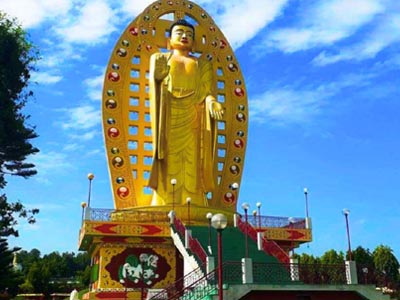
Clock Tower
The Clock Tower of Dehradun, locally known as Ghanta Ghar, is a prominent landmark and cultural heart of the city. This striking hexagonal tower, standing approximately 85 m tall, was constructed between 1948 and 1953 in memory of Lala Balbir Singh — the foundation stone was laid by Sarojini Naidu and it was inaugurated by then Railway Minister Lal Bahadur Shastri.
Each of its six faces once displayed handsome Swiss-imported clocks and bears a golden plaque inscribed with the names of Dehradun's freedom fighters, symbolizing the city's role in India's struggle for independence. Architecturally influenced by Greco styles, the Ghanta Ghar's unique design once allowed its hourly chimes to resonate across the city. Although the original mechanical clocks are no longer functional, replacements were installed recently, bringing its bells back to life in August 2019 after nearly a decade of silence.

Lachhiwala
About 20–22 km from Dehradun city along the Haridwar–Rishikesh Road, Lachhiwala—also known as Lachhiwala Nature Park—is a charming riverside picnic spot renowned for its lush surroundings and cooling natural pools.Surrounded by towering Sal and deciduous trees, the park offers a peaceful escape from the city’s bustle and is maintained by the forest department
The highlight of Lachhiwala is its series of man-made pools filled by the Suswa (or Song) River, ranging from 4 to 7 feet in depth. These shallow pools cascade over small steps and are perfect for wading, swimming, and unwinding under the forest canopy. Visitors enjoy nature walks, light trekking, and birdwatching—making it especially popular with families, youth groups, and nature lovers.

Malsi Deer Park (Dehradun Zoo)
Malsi Deer Park, also known as Dehradun Zoo, is a serene wildlife retreat nestled about 10 km from Dehradun city center along the Mussoorie Road, within the lush foothills of the Shivalik range. Established in 1976, the park spans approximately 25 hectares (about 62.5 acres), with around 5 hectares currently open to visitors, while the rest is part of the larger Malsi Reserved Forest.
The park is famed for its graceful deer—spotted deer, sambar, barking deer, nilgai, two‑horned deer, and even blackbuck roaming in spacious enclosures resembling their natural habitat. Beyond deer, visitors can spot peacocks, rabbits, crocodiles, turtles, occasionally lions and tigers, plus a wide variety of birds including owls, parakeets, emus, and ostriches. A newly opened Aquatic World aquarium showcases rare fish such as silver sharks, Oscars, and jaguar fish.

Haridwar is famous as a holy city in Hinduism, particularly for its association with the river Ganges and as a gateway to the Char Dham pilgrimage. It is one of the four places where the Kumbh Mela festival is held, a major Hindu pilgrimage and festival. The city is also known for Har Ki Pauri, a sacred ghat where the Ganges River enters the plains, and for its nightly Ganga Aarti ceremony.
Har Ki Pauri
Har Ki Pauri is the spiritual heart of Haridwar and one of the most sacred ghats on the banks of the holy Ganga River. The name means “Steps of Lord Vishnu,” and legend has it that Lord Vishnu and Lord Shiva visited this spot in ancient times. It is also believed that a few drops of the elixir of immortality (amrit) fell here during the Samudra Manthan, making it one of the four locations of the Kumbh Mela.
The ghat is best known for its Ganga Aarti, a mesmerizing ritual held every evening at sunset. Devotees gather in thousands to witness priests offering fire to the river with synchronized chants, bells, and lamps. The sight of floating diyas (lamps) on the river creates a deeply spiritual and unforgettable atmosphere.

Chandi Devi Temple
Chandi Devi Temple is one of the most revered temples in Haridwar, perched atop the Neel Parvat in the Shivalik Hills. Dedicated to Goddess Chandi, a fierce form of Durga, the temple is a major Shakti Peetha and attracts thousands of devotees throughout the year.
The temple was built in 1929 by the King of Kashmir, Suchat Singh, but the idol of Chandi Devi is believed to have been installed in the 8th century by Adi Shankaracharya, one of India’s greatest spiritual reformers.
According to legend, Goddess Chandi appeared here to kill the demons Shumbha and Nishumbha, who had taken control of heaven. After her victory, she rested on the hill where the temple now stands.
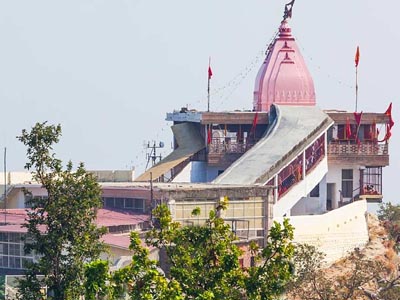
Maya Devi Temple
Maya Devi Temple is one of the most ancient and spiritually significant temples in Haridwar, Uttarakhand. Dedicated to Goddess Maya, a form of Shakti (divine feminine energy), this sacred site holds immense religious value as it is believed to be one of the 51 Shakti Peethas in India.
According to Hindu mythology, the temple marks the spot where the heart and navel of Goddess Sati fell when Lord Shiva carried her burnt body across the universe. Because of this, Maya Devi Temple is not only a symbol of deep devotion but also a powerful center of spiritual energy.
The temple dates back to the 11th century, making it one of the oldest temples in Haridwar, and was once considered the main deity of the city. In fact, Haridwar was historically known as Mayapuri, named after Goddess Maya herself.

Shantikunj
Shantikunj is a renowned spiritual and social reform center located in Haridwar, Uttarakhand. Established in 1971 by Pt. Shriram Sharma Acharya, the founder of the All World Gayatri Pariwar (AWGP), Shantikunj serves as a hub for moral, spiritual, and cultural awakening.
The campus promotes the teachings of Gayatri Mantra, yoga, sanskars (rituals), and scientific spirituality. Its mission is to revive the rich heritage of Indian culture and guide individuals toward a more disciplined, value-based, and purposeful life.
Spread over a serene campus at the foothills of the Himalayas, Shantikunj is visited by spiritual seekers, students, and families from across India and abroad. It offers free training programs, daily yagna rituals, discourses, and meditation sessions for those seeking inner peace and personal growth.

Daksha Mahadev Temple
Daksha Mahadev Temple, located in Kankhal near Haridwar, Uttarakhand, is a significant Hindu temple dedicated to Lord Shiva. This ancient temple holds great mythological importance as it is associated with the legend of King Daksha Prajapati, the father of Goddess Sati and father-in-law of Lord Shiva.
According to Hindu mythology, it is the site where King Daksha organized a grand yajna (sacrificial ritual) but deliberately did not invite Lord Shiva. Feeling insulted, Sati immolated herself in the sacrificial fire, leading to a fierce sequence of events including Shiva’s immense rage and the creation of the fearsome Virabhadra who destroyed the yajna.
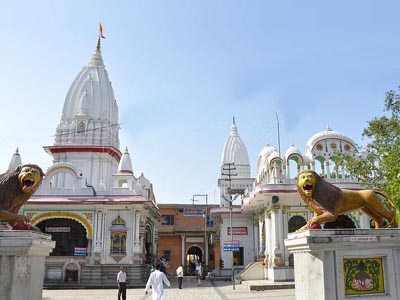
Sapt Rishi Ashram and Sapt Sarovar
Sapt Rishi Ashram and Sapt Sarovar are serene and spiritually significant sites located on the outskirts of Haridwar, Uttarakhand. The ashram is named after the "Sapt Rishis," the seven great sages—Kashyapa, Vashishta, Atri, Vishwamitra, Jamadagni, Bharadwaja, and Gautama—who are believed to have meditated at this sacred spot. According to legend, the Ganges River split into seven streams at this place to avoid disturbing the sages in their deep meditation, giving rise to the tranquil Sapt Sarovar, a group of seven sacred water pools.
The ashram, surrounded by lush greenery and peaceful ambiance, serves as a center for spiritual learning and meditation. It is a popular destination for pilgrims, seekers, and tourists who visit to experience its calm environment, spiritual history, and the natural beauty of the river and surroundings. The combination of mythology, natural beauty, and peaceful atmosphere makes Sapt Rishi Ashram and Sapt Sarovar a must-visit place in Haridwar
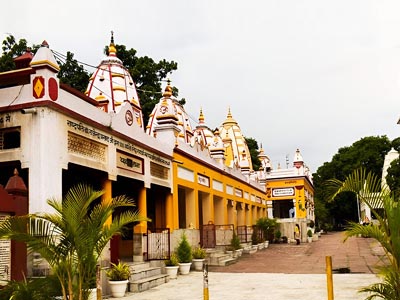
Rajaji National Park
Rajaji National Park, nestled in the Shivalik foothills across Dehradun, Haridwar, and Pauri Garhwal in Uttarakhand, spans about 820 km² and was officially founded as a sanctuary in 1948, later becoming a national park in 1983 and a tiger reserve in 2015. Named after C. Rajagopalachari, the park showcases a diverse mosaic of habitats—including moist deciduous Sal and mixed forests, Chir‑pine stands, savannah woodland, and riparian zones along the River Ganga.
The park shelters over 50 mammals, featuring flagship species like the endangered Bengal tiger, Asian elephant (with 350–500 individuals), leopard, and sloth and Himalayan black bears. Ungulates such as sambar, spotted and barking deer, nilgai, wild boar, and mountain goral roam its slopes. Reptiles include king cobra, Indian python, monitor lizard, and a rich snake fauna.

Mansa Devi Temple
Mansa Devi Temple, located in Haridwar, Uttarakhand, is a highly revered Hindu shrine dedicated to Goddess Mansa Devi, who is believed to fulfill the wishes of her devotees. Perched atop the Bilwa Parvat on the Shivalik Hills, the temple offers a panoramic view of the holy city of Haridwar and the Ganges River. It is one of the prominent Siddh Peeths and holds immense religious significance, especially during festivals like Navratri and Kumbh Mela.
Devotees can reach the temple either by trekking up the hill or by taking a scenic ropeway ride known as the "Mansa Devi Udankhatola." Inside the temple, the idol of Mansa Devi is depicted with three mouths and five arms, symbolizing her divine power. The temple is not only a spiritual center but also a popular tourist attraction, drawing thousands of pilgrims and visitors every year who seek blessings, peace, and spiritual solace.
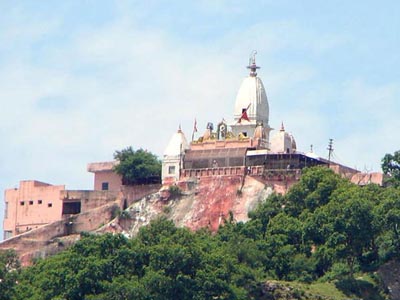
Mussoorie, known as the "Queen of the Hills," is a popular hill station in Uttarakhand, India, renowned for its natural beauty and pleasant climate. It offers stunning views of the Himalayan snow ranges and the Doon Valley, and is a gateway to the Char Dham shrines, Yamunotri and Gangotri. Mussoorie also boasts a vibrant culture, with charming cafes, markets, and a lively atmosphere, especially during the summer season.
Landour – The Quiet Soul of Mussoorie
Landour Located just a few kilometers above the popular hill station of Mussoorie, Landour is a peaceful and charming cantonment town that offers a refreshing escape from the tourist hustle. Nestled in the Garhwal Himalayas at an altitude of over 7,000 feet, Landour is known for its colonial architecture, forested trails, literary heritage, and stunning mountain views.
Originally developed by the British as a convalescent station, Landour still retains its old-world charm with stone pathways, ivy-clad cottages, and churches dating back to the 19th century. The area is less commercialized and quieter than Mussoorie, making it ideal for travelers seeking solitude, nature, and slow travel.

Rokeby Manor
Perched at approximately 7,500 feet above sea level on the highest ridge of Landour, Rokeby Manor is a beautifully restored 19th-century English‑style country estate that transports guests to a bygone era while offering modern comforts.
Originally built in 1840 by Captain G. N. Cauthy, the property later passed through several notable hands—including Frederick “Pahari” Wilson and the Woman’s Foreign Missionary Society—before becoming a heritage hotel

Kempty Falls
Kempty Falls is a beautiful and popular waterfall located about 15 kilometers from Mussoorie and approximately 45 kilometers from Dehradun. Set at an altitude of around 1,364 meters, it is one of the most visited spots in the region, known for its scenic beauty and cascading water that falls from a height of roughly 40 feet. Surrounded by lush green hills, the falls create a natural pool at the base, where visitors can enjoy bathing and relaxing in the cool waters.
A ropeway is available for those who prefer not to walk down the steps, offering a convenient and scenic ride. The area around Kempty Falls is dotted with small eateries, tea stalls, and local shops, making it a great spot for a picnic or a casual day out.

George Everest House
George Everest House is situated about 6 kms from Gandhi Chowk in Mussoorie and one of the major tourist attractions in Mussoorie which is secluded and peaceful. It offers spectacular views of the snow-clad Himalayan peaks and panoramic views of the Doon Valley.
Sir George Everest's House and Laboratory, also known as the Park Estate was built in 1832. These days the George Everest House and George Everest Peak are famous for camping, picnics and adventure outings. Being close to Mussoorie and Dehradun, it is getting popular day by day.
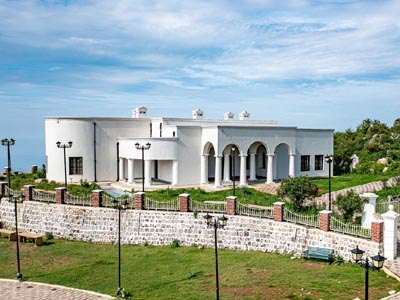
Atal Udyan
Atal Udyan , formerly known as Company Garden, is a popular tourist attraction located about 3 kilometers from Mussoorie’s Mall Road. Originally established during the British era, the garden was renamed in honor of former Prime Minister Atal Bihari Vajpayee.
It features beautifully maintained lawns, vibrant flowerbeds, a small artificial lake with boating facilities, and a range of recreational activities including a toy train and amusement rides for children. The garden is ideal for family outings and picnics, offering food stalls, souvenir shops, and a relaxed atmosphere. Surrounded by lush greenery and nestled in the hills, Atal Udyan is a refreshing spot to unwind while exploring the Queen of Hills.
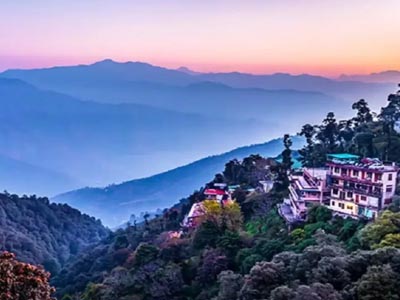
Gun Hill
Gun Hill is one of the most popular tourist attractions in Mussoorie, Uttarakhand, known for its historical significance and stunning panoramic views of the surrounding hills and valleys. Situated at an altitude of about 2,024 meters above sea level, it is the second-highest peak in Mussoorie.
The hill derives its name from the colonial era when a cannon was mounted on this hill and fired every afternoon to help locals synchronize their watches. Today, Gun Hill is a favored viewpoint that offers breathtaking vistas of the Himalayan ranges, including peaks like Srikantha, Bandarpunch, and Pithwara, as well as the Doon Valley below.

Mall Road
Mall Road in Mussoorie is the vibrant heart of the hill station, stretching between the two bustling ends of Library Chowk and Picture Palace. Lined with a variety of shops, cafes, restaurants, and hotels, it is a lively promenade where visitors can enjoy leisurely walks while soaking in the colonial charm and scenic views of the Doon Valley. The road is famous for its old-world architecture, vintage lampposts, and benches that offer perfect spots to sit and admire the surrounding hills.
A popular attraction for tourists, Mall Road offers something for everyone—whether it’s shopping for souvenirs, woolens, handicrafts, or enjoying local snacks and street food. The area also features several viewpoints, including spots that offer breathtaking sunset views over the valley. Horse rides, gaming parlors, and small amusement areas add to its appeal for families and children.

Jharipani Falls
Jharipani Falls is a hidden gem nestled about 7–9 km downhill from Mussoorie’s Library Chowk, in the quaint village of Jharipani near Barlowganj. This serene waterfall drops approximately 20–30 m into a moss‑lined emerald pool, framed by dense oak, rhododendron, and deodar forest. Accessible via a gentle 1.5–2 km trek from the road, the trail is a delightful mix of heritage pathways. forest ambiance, and occasional wildlife sightings.
Open daily from 7 AM to 6 PM with no entry fee, it offers the perfect escape for picnics, photography, bird‑watching, or a quiet moment with nature. During monsoon (July–September), the falls roar to life, offering spectacular views—though caution is advised due to slippery paths. In other seasons, it’s a gentle cascade ideal for dipping your feet in its cool, clear pool and unwinding in peaceful surroundings.

Dalai Hills
Dalai Hills — also known as Happy Valley Gompa — is a serene and spiritually rich vantage point just above the Tibetan settlement in Mussoorie, roughly 400 m from the Shedup Choephelling Temple in Happy Valley. Perched at about 1,970 m (6,400 ft), it offers sweeping panoramic views of the Doon Valley and the mighty Garhwal Himalayas on clear days, making sunrise and sunset particularly magical.
The hill is adorned with fluttering Tibetan prayer flags and features a prominent golden statue of Buddha installed by the 20ᵗʰ Regional Tibetan Youth Congress in 2014—intended as a symbol of peace and protection. A moderate 400 m walk (or short trek) leads visitors past rustic railings and forested trails—adding a delightful layer of adventure.

Rishikesh, often called the "Yoga Capital of the World," is a city in the foothills of the Himalayas, known for its spiritual atmosphere, yoga and meditation centers, and adventure activities. It's a popular destination for those seeking spiritual enlightenment, yoga retreats, and exploring the natural beauty of the region.
Lakshman Jhula
Lakshman Jhula is one of the most iconic landmarks in Rishikesh, Uttarakhand. It is a suspension bridge built across the Ganga River, connecting the two villages of Tapovan in Tehri Garhwal and Jonk in Pauri Garhwal.
his historic bridge, 450 feet long and 70 feet above the river, was constructed in 1929 and is named after Lord Lakshman, the younger brother of Lord Rama. According to legend, Lakshman once crossed the river at this very spot using a jute rope, and the current iron bridge commemorates that divine crossing.
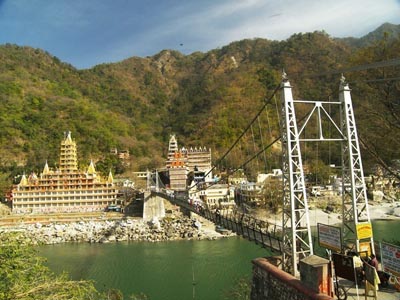
Triveni Ghat
Triveni Ghat is the most sacred and well-known bathing ghat in Rishikesh, located on the banks of the holy Ganga River. It holds deep spiritual significance as it is believed to be the confluence (Triveni) of three holy rivers: Ganga, Yamuna, and Saraswati.
Pilgrims from across India come to take a holy dip at Triveni Ghat, believing it cleanses sins and purifies the soul. The ghat is also a place where rituals like shraddh, pujas, and Ganga snan (ritual bathing) are performed daily.

Parmarth Niketan Ashram
Parmarth Niketan is one of the largest and most renowned ashrams in Rishikesh, located on the banks of the holy Ganga River near Ram Jhula. Founded in 1942, it is a peaceful haven for spiritual seekers from around the world, offering an ideal blend of yoga, spirituality, nature, and service.
The ashram is home to more than 1,000 rooms and hosts daily programs including yoga classes, meditation sessions, spiritual lectures, and Ganga Aarti. Its beautifully maintained campus features lush gardens, sacred temples, and the towering statue of Lord Shiva, which has become a symbol of Rishikesh.

Tera Manzil Temple
Tera Manzil Temple, also known as Trayambakeshwar Temple, is a prominent and visually striking Hindu temple located near Lakshman Jhula in Rishikesh, Uttarakhand. As its name suggests, the temple has 13 floors (Tera Manzil) and is dedicated to Lord Shiva, also known as Trayambakeshwar – the three-eyed god.
What makes this temple unique is that each of its thirteen stories houses different deities, allowing devotees to worship various gods and goddesses under one roof. From Durga, Vishnu, Hanuman, and Radha-Krishna to other avatars, it offers a spiritual journey floor by floor.
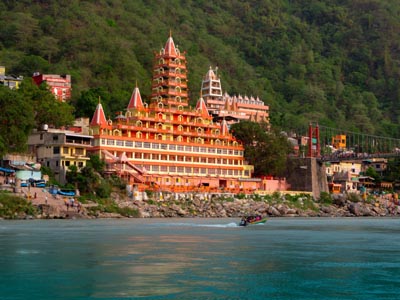
Ram Jhula
Ram Jhula is an iconic iron suspension bridge located in Rishikesh, Uttarakhand, spanning the holy Ganges River. Built in 1986, this pedestrian bridge connects the spiritual towns of Muni Ki Reti and Swarg Ashram, serving as both a vital link and a major attraction for pilgrims and tourists alike. Stretching about 450 feet, Ram Jhula offers stunning views of the Ganges, surrounding hills, and the numerous temples and ashrams dotting both banks.
Ram Jhula is not just a means of crossing the river but also a cultural and spiritual experience. The bridge leads to several renowned ashrams and temples such as Parmarth Niketan, Geeta Bhawan, and Swarg Ashram, making it a hub for yoga enthusiasts, saints, and seekers of peace.

Neelkanth Mahadev Temple
Neelkanth Mahadev Temple, nestled about 32 km from Rishikesh at an elevation of around 1,330 m, is a revered Himalayan shrine dedicated to Lord Shiva in his form as “Neelkanth”—the Blue-Throated One. Perched at the serene confluence of the Pankaja and Madhumati rivers, and flanked by the forested valleys of Manikoot, Brahmakoot, and Vishnukoot, the temple lies in a tranquil, scenic setting
The temple commemorates Shiva’s legendary sacrifice during the Samudra Manthan (churning of the ocean)—when he drank the deadly Halahala poison to save creation, turning his throat blue. Tradition holds that he meditated at this very site under the Panchpani tree for 60,000 years, installing a throat-shaped Shiva-linga
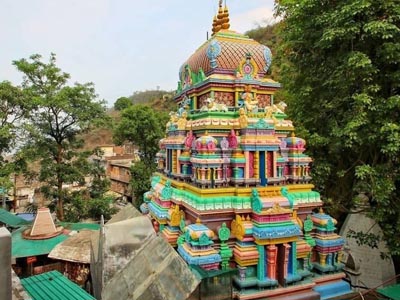
Shivpuri
Shivpuri is a scenic riverside hamlet nestled approximately 16–19 km upstream from Rishikesh, tucked into the lush Himalayan foothills beside the roaring Ganges. Known as the “Abode of Shiva,” it features several small temples and ashrams that lend a spiritual aura to its adventurous vibe. Shivpuri is a premier destination for white‑water rafting, offering exhilarating Grade III–IV rapids like “Return to Sender” and “Roller Coaster” over a 16 km stretch.
The area brims with lively river‑side camps where visitors can enjoy bonfires, stargazing, cliff jumping, kayaking, and guided jungle treks. It’s also a tranquil spot for yoga, meditation, or simply soaking in the natural beauty. Easily accessible by road from Rishikesh and close to attractions like Neelkanth Mahadev Temple, Rajaji National Park, and Neer Garh Waterfall, Shivpuri beautifully blends adrenaline‑packed adventure, spiritual calm, and scenic Himalayan charm.

Kunjapuri Temple
Kunjapuri Temple, perched at about 1,676 m near Narendra Nagar above Rishikesh, is a revered Shakti Peeth dedicated to Goddess Durga/Parvati—believed to be where the chest of Sati fell during Shiva's cosmic dance, according to legend.As one of the three prominent Siddha Peethas in Tehri Garhwal, it forms a spiritual triangle with Surkanda Devi and Chandrabadni
Renowned for its breathtaking sunrise and sunset panoramas, the temple offers sweeping views of the Himalayan peaks—Swargarohini, Gangotri, Bandarpoonch, Chaukhamba—and the Bhagirathi valley, including Rishikesh, Haridwar, and the Doon Valley. It’s a pilgrimage and trekking favorite, with access via motorable road or a 5 km forest trek from Hindolakhal, followed by a climb of around 80–300 steps to the shrine.
